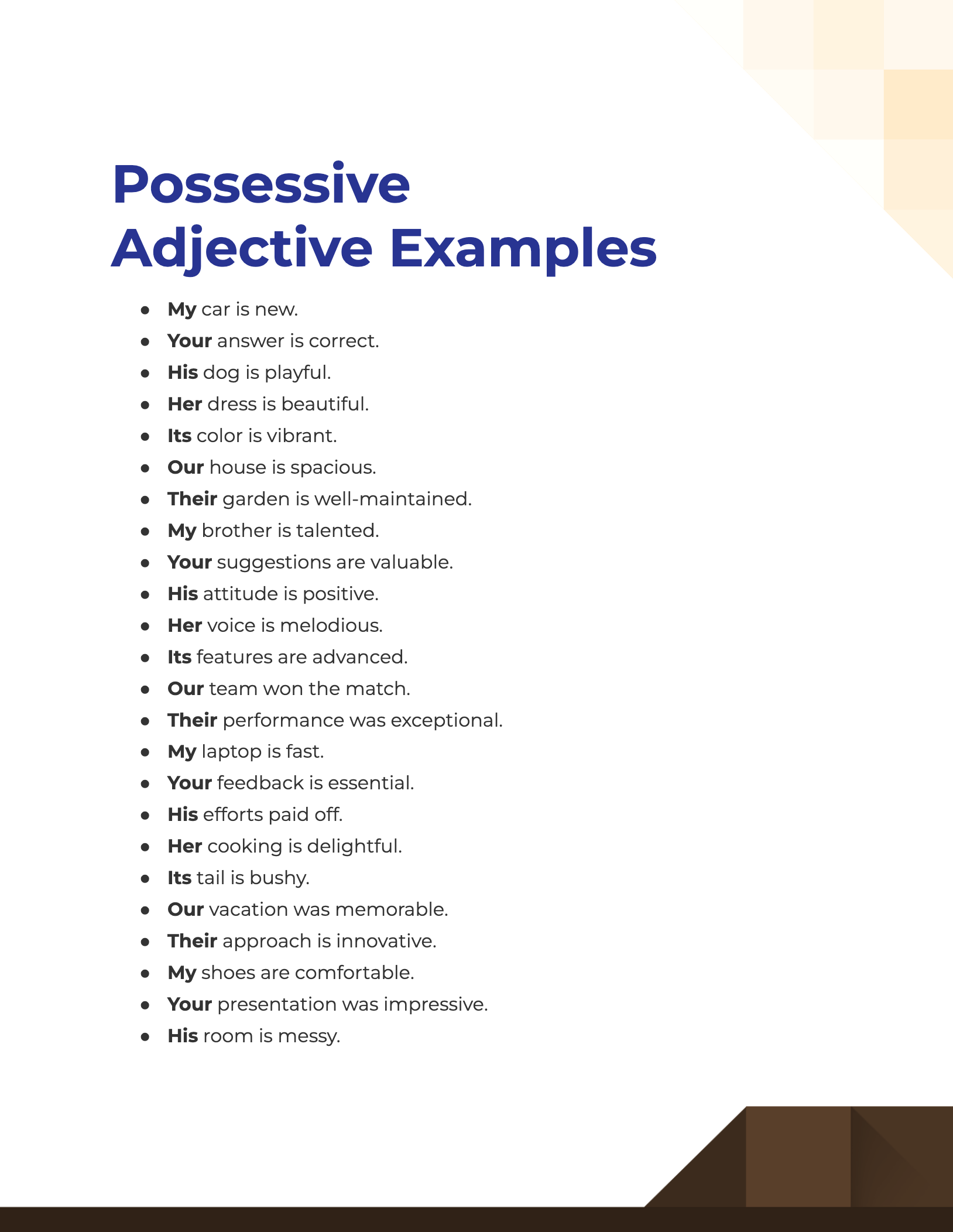Possessive Adjective
Unlock the nuanced world of possessive adjectives with our in-depth guide. As essential grammar tools, these adjectives bring clarity and ownership to sentences. Delve into enlightening adjective examples, harness the power of effective usage, and amplify your linguistic prowess with our expert tips.
What is the Possessive Adjective? – Definition
A possessive adjective is a word that indicates ownership or belonging and comes before a noun in a sentence. In English, common possessive adjectives include “my,” “your,” “his,” “her,” “its,” “our,” and “their.”
What is the Best Example of a Possessive Adjective?
Consider the sentence, “This is her book.” Here, the word “her” is a possessive adjective. It indicates ownership, suggesting that the book belongs to a particular female individual. The adjective gives context, letting us know who the owner of the book is.
100 Possessive Adjective Examples

Possessive adjectives are pivotal in painting a clear picture of ownership in the English language. Whether it’s signifying personal belongings or highlighting relationships, these tiny grammar warriors are indispensable. Enhance your vocabulary with our curated list of 100 distinct examples that showcase the dynamism and versatility of possessive adjectives.
- My car is new.
- Your answer is correct.
- His dog is playful.
- Her dress is beautiful.
- Its color is vibrant.
- Our house is spacious.
- Their garden is well-maintained.
- My brother is talented.
- Your suggestions are valuable.
- His attitude is positive.
- Her voice is melodious.
- Its features are advanced.
- Our team won the match.
- Their performance was exceptional.
- My laptop is fast.
- Your feedback is essential.
- His efforts paid off.
- Her cooking is delightful.
- Its tail is bushy.
- Our vacation was memorable.
- Their approach is innovative.
- My shoes are comfortable.
- Your presentation was impressive.
- His room is messy.
- Her ideas are unique.
- Its design is modern.
- Our city is bustling.
- Their products are eco-friendly.
- My dream is to travel.
- Your company is reputed.
- His opinion matters.
- Her writings are inspiring.
- Its battery lasts long.
- Our traditions are rich.
- Their commitment is commendable.
- My hobby is painting.
- Your skills are unmatched.
- His collection is vast.
- Her beauty is natural.
- Its texture is soft.
- Our goals are aligned.
- Their dedication is unwavering.
- My phone has a good camera.
- Your assistance is appreciated.
- His knowledge is vast.
- Her garden is blooming.
- Its aroma is intoxicating.
- Our journey was adventurous.
- Their solutions are practical.
- My book is on the top shelf.
- Your sense of humor is refreshing.
- His artwork is intricate.
- Her passion is dance.
- Its lifespan is short.
- Our mission is to help.
- Their feedback is constructive.
- My favorite color is blue.
- Your approach is systematic.
- His character is strong.
- Her intuition is sharp.
- Its value has increased.
- Our bond is unbreakable.
- Their restaurant is popular.
- My choice is different.
- Your insights are enlightening.
- His charm is undeniable.
- Her strength is commendable.
- Its origin is unknown.
- Our achievements are significant.
- Their traditions are age-old.
- My ambition is high.
- Your kindness is touching.
- His strategies are effective.
- Her smile is contagious.
- Its significance is profound.
- Our values are shared.
- Their energy is infectious.
- My interest is genuine.
- Your talent is evident.
- His perspective is unique.
- Her solution is optimal.
- Its details are intricate.
- Our respect is mutual.
- Their resilience is admirable.
- My goal is clear.
- Your courage is inspiring.
- His legacy is lasting.
- Her drive is unstoppable.
- Its outcome is uncertain.
- Our traditions are cherished.
- Their memories are treasured.
- My intuition is reliable.
- Your generosity is known.
- His feedback is valuable.
- Her elegance is graceful.
- Its essence is pure.
- Our priorities are set.
- Their vision is futuristic.
- My spirit is indomitable.
- Your dedication is evident.
Through these diverse examples, one can clearly see the pivotal role that possessive adjectives play in providing context, indicating relationships, and establishing ownership in the English language.
Possessive Adjective Sentence Examples
Dive into the realm of possessive adjectives with our well-curated list of sentence examples. Perfect for honing grammar skills, these sentences offer a practical demonstration of how these adjectives embed themselves seamlessly in everyday English.
- My brother has a knack for painting.
- Your creativity truly shines in this project.
- She admired his determination throughout the challenge.
- Her necklace is a vintage piece.
- Its colors are mesmerizing to the eye.
- Our family reunion is scheduled for next month.
- Their achievements in the field are commendable.
- My favorite dessert is chocolate mousse.
- Your understanding of the topic is profound.
- The bird spread its wings and soared high.
Possessive Adjective Examples for Kids
Simplifying possessive adjectives for young minds, our kid-friendly list is tailored to resonate with their understanding. Through relatable and straightforward examples, children can easily grasp the concept of ownership in language.
- My toy is in the playroom.
- Is your ice cream chocolate-flavored?
- His bicycle has bright red stickers.
- Her doll has a blue dress.
- The cat is licking its paw.
- Our teacher read us a story.
- Their playground has a big slide.
- My pencil is sharp.
- Can I play with your toy truck?
- The dog wagged its tail happily.
What is the Basic Rule for a Possessive Adjective?
Possessive adjectives serve as essential markers to indicate ownership or association. The fundamental rule is straightforward: a possessive adjective should precede and modify a noun, thereby clarifying who or what the noun belongs to. Unlike possessive pronouns which stand alone, possessive adjectives always need a noun after them.
For instance, in the sentence “This is my book,” the possessive adjective “my” modifies the noun “book,” clarifying ownership.
How Do You Identify Possessive Adjectives?
Identifying possessive adjectives in a sentence can initially seem challenging, but with a few steps, it becomes more straightforward:
- Look for Ownership: These adjectives indicate ownership or association. If a word in the sentence provides a sense of belonging, it’s a potential candidate.
- Check for Nouns: Possessive adjectives will always precede a noun. For example, in “her car,” “her” is the possessive adjective modifying the noun “car.”
- Distinct Forms: They have distinct forms that don’t change for gender or number, unlike other adjectives in English. For instance, we use “her” regardless of whether the noun it modifies is singular or plural.
- Eliminate Possessive Pronouns: Remember that words like “mine,” “yours,” “hers,” “ours,” “theirs” are possessive pronouns and stand alone. They don’t modify nouns and are thus different from possessive adjectives.
What are the 7 Possessive Pronoun Adjectives?
Possessive adjectives, often known as possessive pronoun adjectives, are used to show possession or ownership. The primary seven in English are:
- My – Belonging to the speaker. Example: “My phone is charged.”
- Your – Belonging to the person being spoken to. Example: “Your idea is fantastic.”
- His – Belonging to a male person being spoken about. Example: “His jacket is blue.”
- Her – Belonging to a female person being spoken about. Example: “Her dress is lovely.”
- Its – Belonging to a neutral or non-human entity being spoken about. Example: “The cat ate its food.”
- Our – Belonging to a group that includes the speaker. Example: “Our team won the match.”
- Their – Belonging to a group being spoken about. Example: “Their performance was captivating.”
Understanding the usage and nuances of these possessive adjectives is crucial for constructing clear and precise sentences in English.
How to Practice Possessive Adjectives?
Practicing possessive adjectives is vital for perfecting grammar and ensuring clear communication. Here are some effective methods:
- Interactive Worksheets: There are countless online platforms offering worksheets specifically designed for possessive adjectives. Regular practice can solidify understanding.
- Daily Journaling: Write a few sentences daily using possessive adjectives. This routine not only improves grammar but also enhances writing skills.
- Flashcards: On one side, write a sentence with a blank, and on the other, the correct possessive adjective. This method helps in testing and reinforcing your knowledge.
- Read Aloud: Reading books or articles aloud and emphasizing possessive adjectives can improve pronunciation and understanding.
- Language Exchange: Pair up with someone to practice speaking. Conversing helps identify common mistakes and rectify them.
- Games and Quizzes: Engage in grammar games or quizzes focusing on possessive adjectives. They make learning interactive and fun.
How to Use a Possessive Adjective? – Step by Step Guide
Using possessive adjectives correctly can provide clarity in communication. Here’s a methodical approach:
- Identify the Owner: Determine who or what owns the item in context.
- Determine Gender and Number: Check if the owner is male, female, neutral, singular, or plural. This will decide which possessive adjective to use.
- Select the Possessive Adjective: Choose the appropriate possessive adjective based on the owner’s identity.
- Place Before the Noun: Always place the possessive adjective directly before the noun it modifies.
- Review: Ensure that the adjective and the noun make sense together, providing clear context of ownership.
Tips for Using Possessive Adjective
Here are some invaluable tips for using possessive adjectives:
- Avoid Ambiguity: Make sure the context clearly defines who or what the possessive adjective refers to. If not, restructure the sentence.
- Watch for “Its vs. It’s”: One common mistake is confusing “its” (possessive adjective) with “it’s” (contraction for “it is” or “it has”). Always double-check.
- Pair with Appropriate Nouns: Ensure that the noun following the possessive adjective logically belongs to the entity referred to. For instance, “our car” makes sense if referring to a family’s shared vehicle.
- Practice Regularly: Like any other grammar component, regular practice will cement your understanding and usage of possessive adjectives.
- Seek Feedback: Especially when learning, ask others to review your writing or listen to your speech to catch any mistakes related to possessive adjectives.
Armed with these guidelines, mastering possessive adjectives becomes an achievable feat, paving the way for clearer, more effective communication.



